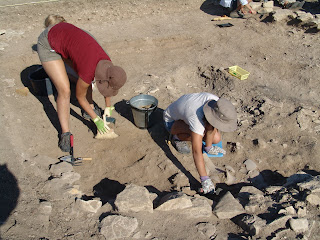Archaeological excavations in the necropolis of ancient Orgame /Argamum started in 1988 and since then have been carried out annually with systematic research programmes headed from 1990 onwards by Dr. Vasilica Lungu (Institute of South East European Studies , Romanian Academy , Bucharest
The archaeological evidence has revealed the presence of distinctive cremation graves with certain unusual features within the Greek necropolis. The cremations and cremation pits are usually marked by stone circles and covered over by tumuli which cluster within family plots. These are systematically distributed along ancient roads leading out of the city. They are accompanied by rich votive gifts, identified mainly by ceramic vessels as part of funerary deposits which offer a fairly complete notion of the structure of ancient society.
Such funerary practices continued over a long interval of time, from the second half of the 7th to the middle of the 3rd century BC.
The 2011 season in the Orgame necropolis has been devoted to the excavation of a new family plot of several tombs identified at the western edge of the necropolis.
The archaeological team for the Orgame research programme is directed by Dr. Vasilica Lungu (representing both the Institute of South-East European Studies and the “Vasile Pârvan” Institute of Archaeology, Bucarest), and Dr. Alexandre Baralis (Centre Camille Jullian, Aix-en-Provence), head of the ANR programme “Pont-Euxin”, and is joined by graduate students Alexandra Dolea and Alina Musat (Faculty of History, University of Bucharest,).
A group of Canadian students participated in the 2011 field season, including Nicole Aszalos, Carolyn Clarke, Shelby Haggerty, Frances Jardine, Thomas Krol, Anna Laytner, Amanda MacKinnon, Sarah Timmins, and Katherine Tyka under the guidance of Prof. Dr. Gerald Schaus from Wilfrid Laurier University (Waterloo , Ontario
Also participating for shorter periods of time were, from “Babeș Bolyai” University (Cluj-Napoca ) Dr. Carmen Rogobete with students Claudia Radu and Claudiu Barb and from Dunărea de Jos University (Galați), students Adina Gutu, Micu Simona and from the University of Bucharest
Note: The 2011 excavation season has received generous financial support from the French-Romanian project ANR –“Pont Euxin” 2010-2012; and from the Department of Archaeology and Classical Studies, Wilfrid Laurier University











No comments:
Post a Comment